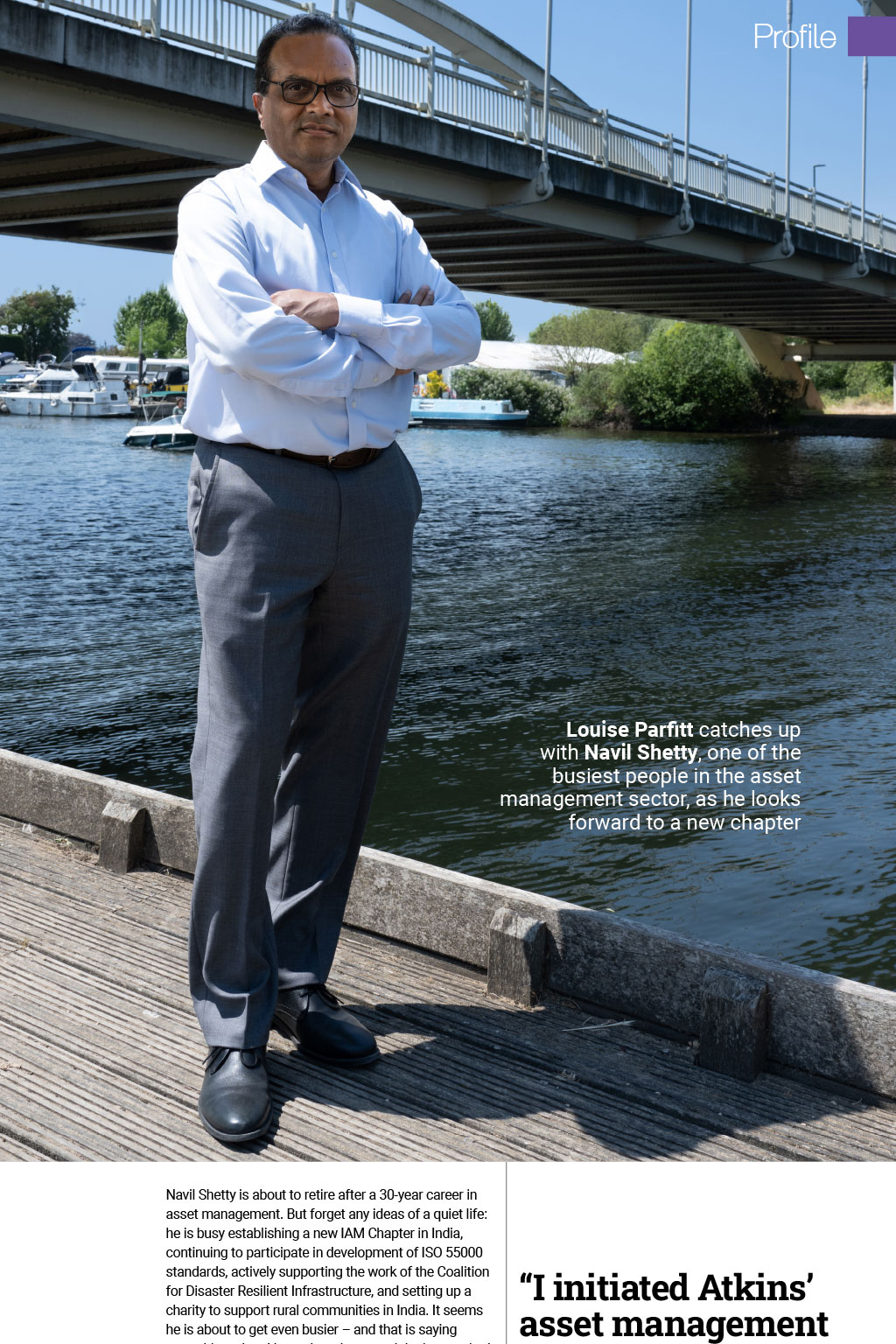
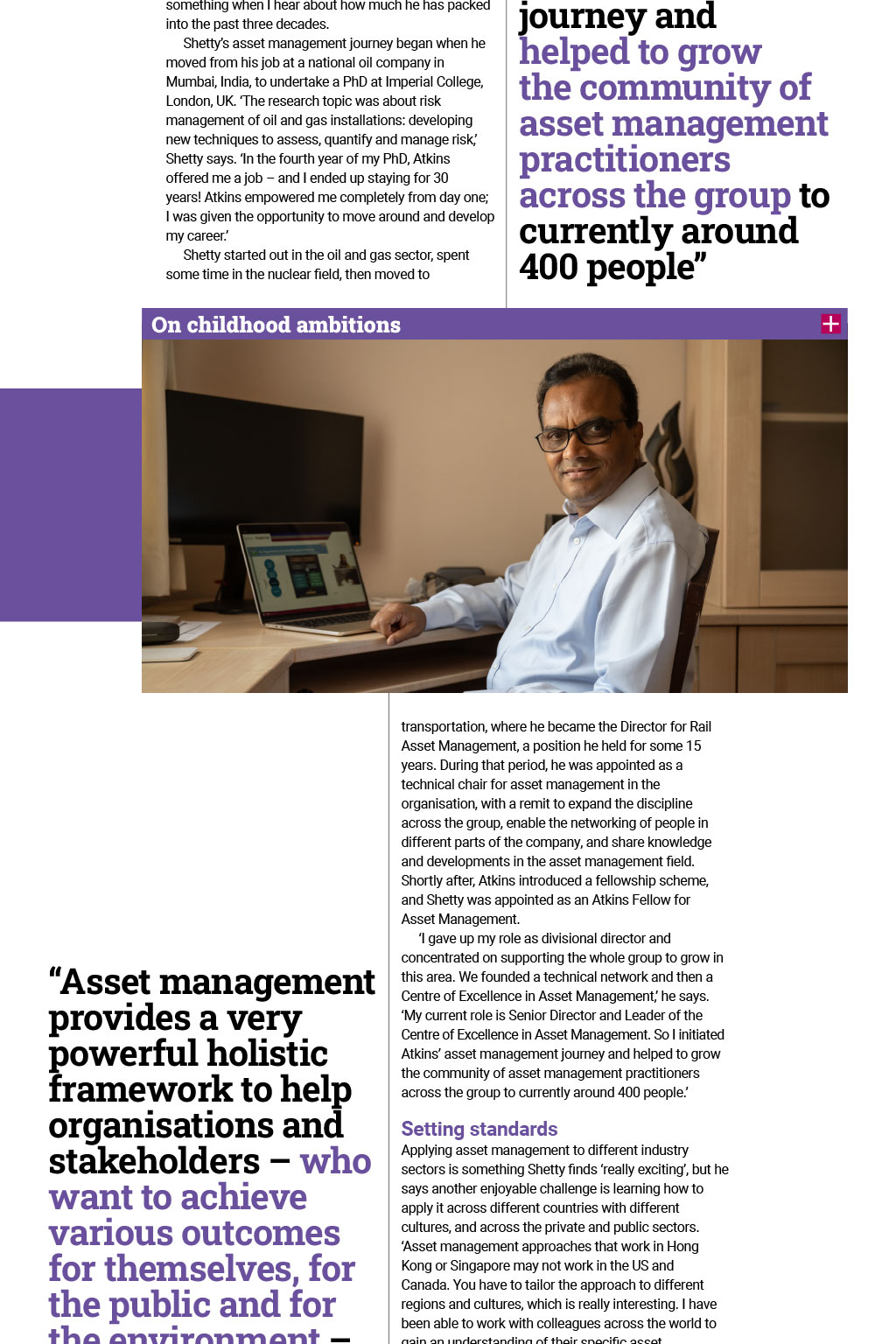
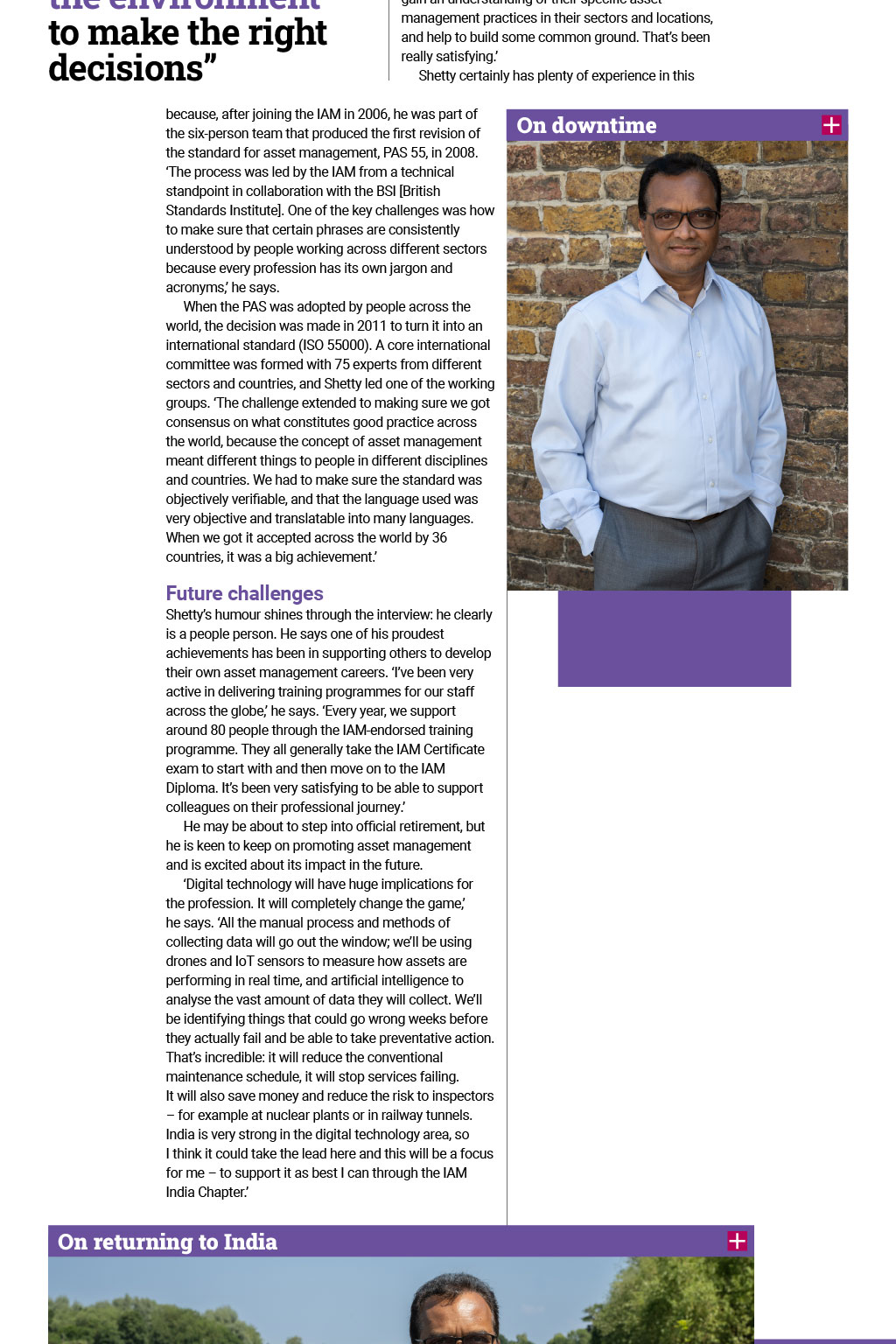
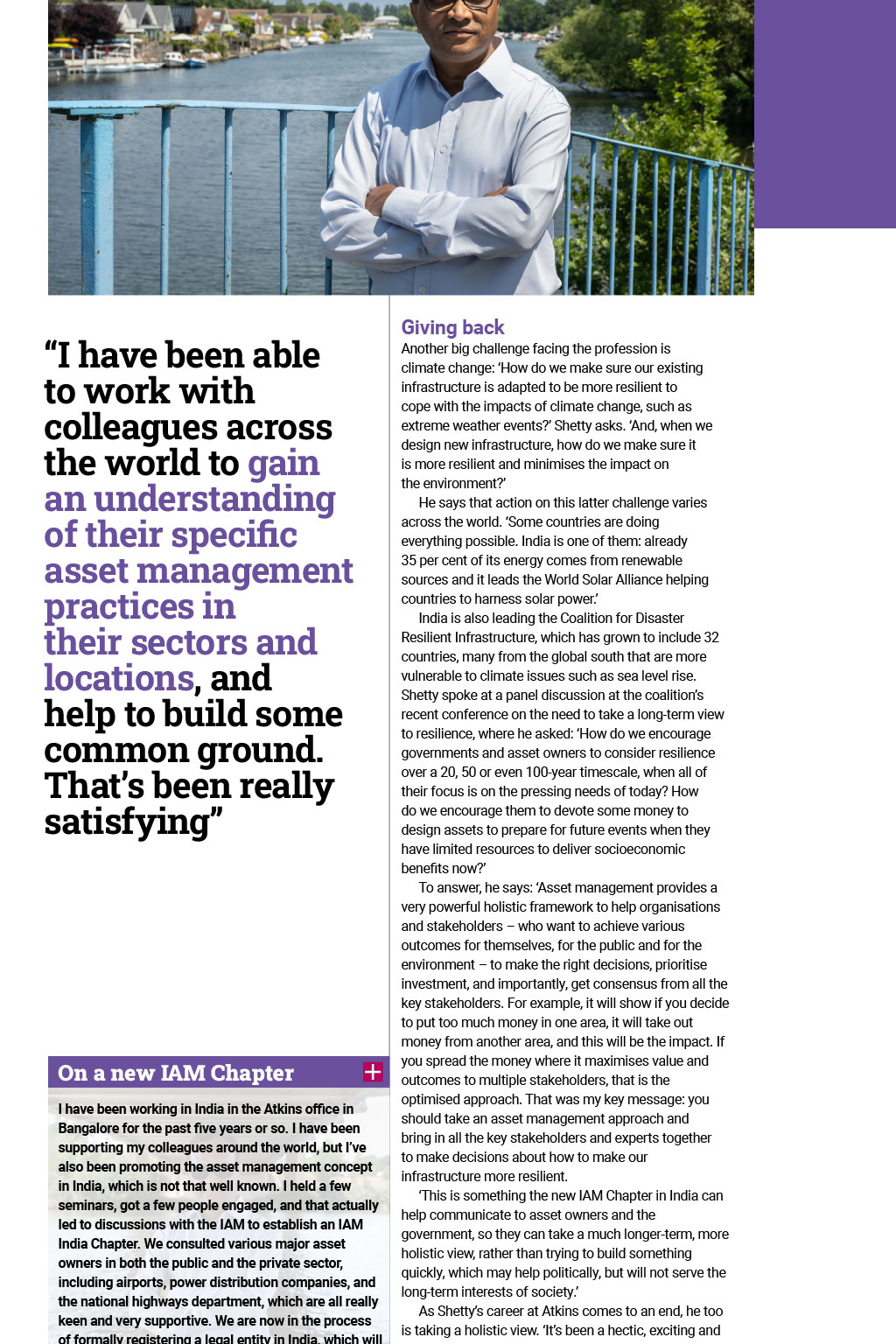
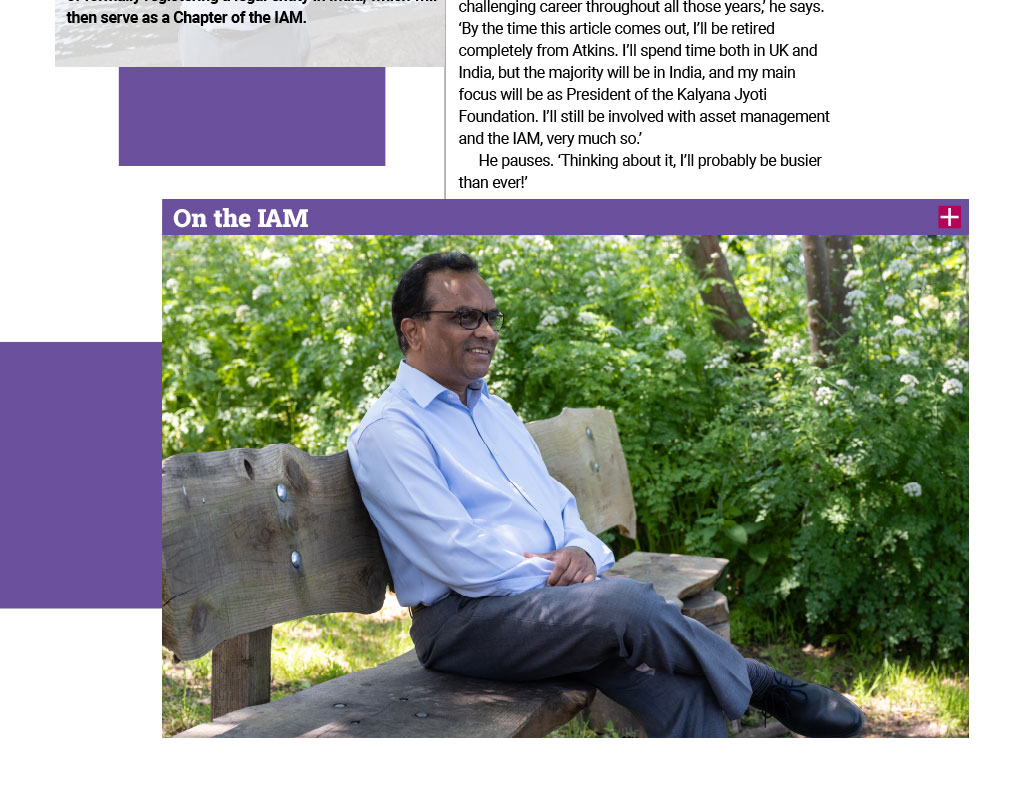





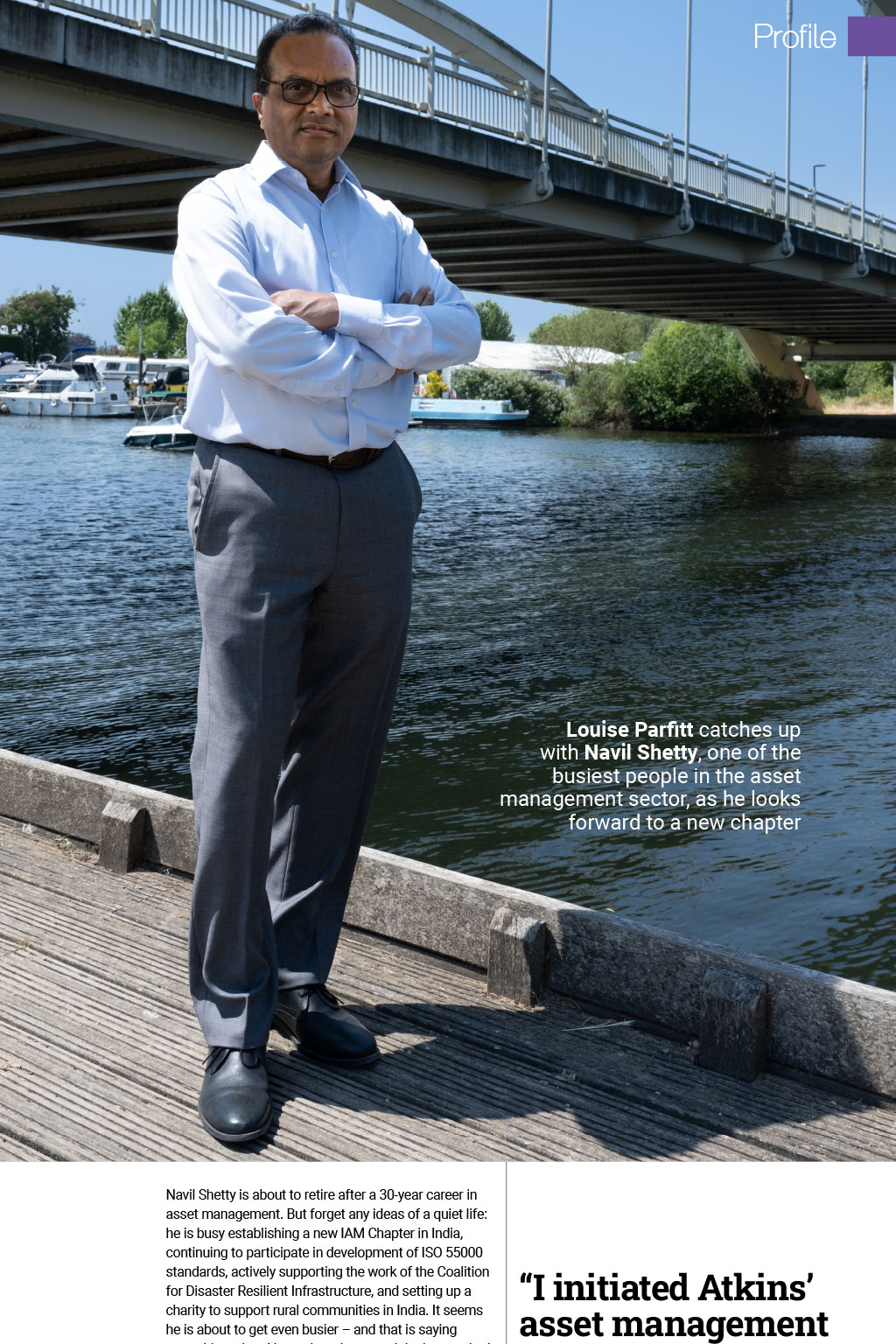
Profile Building bridges Louise Parfitt catches up with Navil Shetty, one of the busiest people in the asset management sector, as he looks forward to a new chapter Navil Shetty is about to retire after a 30-year career in asset management. But forget any ideas of a quiet life: he is busy establishing a new IAM Chapter in India, continuing to participate in development of ISO 55000 standards, actively supporting the work of the Coalition for Disaster Resilient Infrastructure, and setting up a charity to support rural communities in India. It seems he is about to get even busier and that is saying something when I hear about how much he has packed into the past three decades. Shettys asset management journey began when he moved from his job at a national oil company in Mumbai, India, to undertake a PhD at Imperial College, London, UK. The research topic was about risk management of oil and gas installations: developing new techniques to assess, quantify and manage risk, Shetty says. In the fourth year of my PhD, Atkins offered me a job and I ended up staying for 30 years! Atkins empowered me completely from day one; I was given the opportunity to move around and develop my career. Shetty started out in the oil and gas sector, spent some time in the nuclear field, then moved to I initiated Atkins asset management journey and helped to grow the community of asset management practitioners across the group to currently around 400 people On childhood ambitions My eight-year-old self would probably laugh at me now. When I was growing up, especially during my college days, I was very passionate about serving my country I didnt even want to get married! One of the paths I was thinking about was to become a politician. I did well academically, so probably thats what sparked my interest in doing research and coming to the UK to further my studies. And, like most Indians who go abroad, I got stuck and have been based in the UK for 35 years now. Things turned out differently to how I imagined they would, but Ive got no regrets at all. Ive enjoyed every bit of it. Asset management provides a very powerful holistic framework to help organisations and stakeholders who want to achieve various outcomes for themselves, for the public and for the environment to make the right decisions transportation, where he became the Director for Rail Asset Management, a position he held for some 15 years. During that period, he was appointed as a technical chair for asset management in the organisation, with a remit to expand the discipline across the group, enable the networking of people in different parts of the company, and share knowledge and developments in the asset management field. Shortly after, Atkins introduced a fellowship scheme, and Shetty was appointed as an Atkins Fellow for Asset Management. I gave up my role as divisional director and concentrated on supporting the whole group to grow in this area. We founded a technical network and then a Centre of Excellence for Asset Management, he says. My current role is Senior Director and Leader of the Centre of Excellence for Asset Management. So I initiated Atkins asset management journey and helped to grow the community of asset management practitioners across the group to currently around 400 people. Setting standards Applying asset management to different industry sectors is something Shetty finds really exciting, but he says another enjoyable challenge is learning how to apply it across different countries with different cultures, and across the private and public sectors. Asset management approaches that work in Hong Kong or Singapore may not work in the US and Canada. You have to tailor the approach to different regions and cultures, which is really interesting. I have been able to work with colleagues across the world to gain an understanding of their specific asset management practices in their sectors and locations, and help to build some common ground. Thats been really satisfying. Shetty certainly has plenty of experience in this because, after joining the IAM in 2006, he was part of the six-person team that produced the first revision of the standard for asset management, PAS 55, in 2008. The process was led by the IAM from a technical standpoint in collaboration with the BSI [British Standards Institute]. One of the key challenges was how to make sure that certain phrases are consistently understood by people working across different sectors because every profession has its own jargon and acronyms, he says. When the PAS was adopted by people across the world, the decision was made in 2011 to turn it into an international standard (ISO 55000). A core international committee was formed with 75 experts from different sectors and countries, and Shetty led one of the working groups. The challenge extended to making sure we got consensus on what constitutes good practice across the world, because the concept of asset management meant different things to people in different disciplines and countries. We had to make sure the standard was objectively verifiable, and that the language used was very objective and translatable into many languages. When we got it accepted across the world by 36 countries, it was a big achievement. On downtime My wife and I both enjoy travelling. Trekking in the Himalayas is what we love most; Nepal and the northern states of India such as Kashmir and Uttarakhand are very beautiful. India has some amazing architecture and a lot of beautiful and old temples, so wed like to explore more of those, too. Future challenges Shettys humour shines through the interview: he clearly is a people person. He says one of his proudest achievements has been in supporting others to develop their own asset management careers. Ive been very active in delivering training programmes for our staff across the globe, he says. Every year, we support around 80 people through the IAM-endorsed training programme. They all generally take the IAM Certificate exam to start with and then move on to the IAM Diploma. Its been very satisfying to be able to support colleagues on their professional journey. He may be about to step into official retirement, but he is keen to keep on promoting asset management and is excited about its impact in the future. Digital technology will have huge implications for the profession. It will completely change the game, he says. All the manual process and methods of collecting data will go out the window; well be using drones and IoT sensors to measure how assets are performing in real time, and artificial intelligence to analyse the vast amount of data they will collect. Well be identifying things that could go wrong weeks before they actually fail and be able to take preventative action. Thats incredible: it will reduce the conventional maintenance schedule, it will stop services failing. It will also save money and reduce the risk to inspectors for example at nuclear plants or in railway tunnels. India is very strong in the digital technology area, so I think it could take the lead here and this will be a focus for me to support it as best I can through the IAM India Chapter. On returning to India My wife and I always thought wed go back to India, but then the children were settled at school in the UK so we would delay it for a bit longer suddenly 30 years has passed! Our sons have finished their studies and are working now, so we are freer to return. My wife and I are both from the same town, so we have family there we want to spend time with. However, my other main reason for going back to India is to contribute to the social sector. With eight old friends and colleagues, we have established the Kalyana Jyoti Foundation. We support the holistic development of rural areas, be it to provide treated drinking water or solar lighting for a school. The villagers decide what is important for the community and our NGO will support them in terms of providing the knowhow, helping them to access funding and grants and, if required, we can offer some seed funding to get things started. As long as Im fit, whatever I can do to give a little bit back to the society, I want to do. Its very satisfying really. I have been able to work with colleagues across the world to gain an understanding of their specific asset management practices in their sectors and locations, and help to build some common ground. Thats been really satisfying On a new IAM Chapter I have been working in India in the Atkins office in Bangalore for the past five years or so. I have been supporting my colleagues around the world, but Ive also been promoting the asset management concept in India, which is not that well known. I held a few seminars, got a few people engaged, and that actually led to discussions with the IAM to establish an IAM India Chapter. We consulted various major asset owners in both the public and the private sector, including airports, power distribution companies, and the national highways department, which are all really keen and very supportive. We are now in the process of formally registering a legal entity in India, which will then serve as a Chapter of the IAM. Giving back Another big challenge facing the profession is climate change: How do we make sure our existing infrastructure is adapted to be more resilient to cope with the impacts of climate change, such as extreme weather events? Shetty asks. And, when we design new infrastructure, how do we make sure it is more resilient and minimises the impact on the environment? He says that action on this latter challenge varies across the world. Some countries are doing everything possible. India is one of them: already 35 per cent of its energy comes from renewable sources and it leads the World Solar Alliance helping countries to harness solar power. India is also leading the Coalition for Disaster Resilient Infrastructure, which has grown to include 32 countries, many from the global south that are more vulnerable to climate issues such as sea level rise. Shetty spoke at a panel discussion at the coalitions recent conference on the need to take a long-term view to resilience, where he asked: How do we encourage governments and asset owners to consider resilience over a 20, 50 or even 100-year timescale, when all of their focus is on the pressing needs of today? How do we encourage them to devote some money to design assets to prepare for future events when they have limited resources to deliver socioeconomic benefits now? To answer, he says: Asset management provides a very powerful holistic framework to help organisations and stakeholders who want to achieve various outcomes for themselves, for the public and for the environment to make the right decisions, prioritise investment, and importantly, get consensus from all the key stakeholders. For example, it will show if you decide to put too much money in one area, it will take out money from another area, and this will be the impact. If you spread the money where it maximises value and outcomes to multiple stakeholders, that is the optimised approach. That was my key message: you should take an asset management approach and bring in all the key stakeholders and experts together to make decisions about how to make our infrastructure more resilient. This is something the new IAM Chapter in India can help communicate to asset owners and the government, so they can take a much longer-term, more holistic view, rather than trying to build something quickly, which may help politically, but will not serve the long-term interests of society. As Shettys career at Atkins comes to an end, he too is taking a holistic view. Its been a hectic, exciting and challenging career throughout all those years, he says. By the time this article comes out, Ill be retired completely from Atkins. Ill spend time both in UK and India, but the majority will be in India, and my main focus will be as President of the Kalyana Jyoti Foundation. Ill still be involved with asset management and the IAM, very much so. He pauses. Thinking about it, Ill probably be busier than ever! On the IAM I joined the IAM in 2006. I was on the Council for about four years, then I joined the Faculty, and was also part of the Knowledge Leadership Group, and contributed to a number of publications, including the Asset Management Anatomy. I was also involved with developing guidance and best practice, such as the asset management excellence model and tools to assess maturity in asset management. I was awarded the IAM Presidents Award in 2013 and was one of the first 10 Fellows to be appointed by the IAM in 2016.